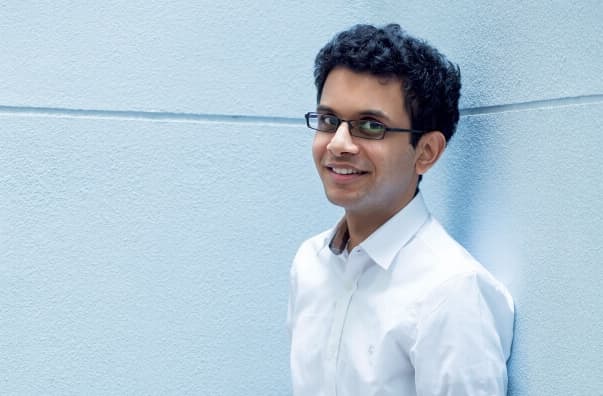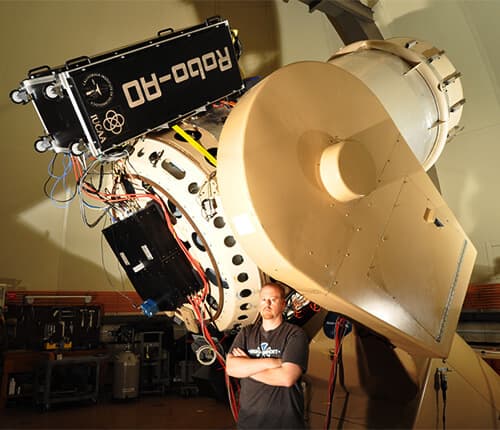Rohan Murthy Funds Robotic Astronomy Project "Robo-AO KP"
Rohan Murthy has funded the Robo-AO KP project, world's only fully robotic adaptive optics system; being developed by Caltech (USA) and IUCAA (Pune, India). Murthy's set aside $1 million to automate the discovery of the Universe and says that it will impact one of the oldest activities of humans - wondering about our own place in the entire Universe. He further said that this activity has become an inspirational source for religion, poetry, our science and culture and he's happy to support the Robo-AO project.
Murthy expressed his confidence that the project will act as a new frontier to demonstrate what computer science and engineering can do for astronomy and humans, in general.

Rohan Murthy. Image Credit: elle.in
The system developed by team led by Christoph Baranec from the University of Hawaii will be moved to the Kitt Peak National Observatory, which has a 2.1 meter telescope. The project had to seek funds because of the budget cuts at Caltech and that's exactly where Murthy decided to help. The system allows astronomers and researchers to take highly detailed images of wide range of celestial objects.
It's interesting to note that the prototype of the Robo-AO system has been functioning, though part time at the Palomar Observatory for about five years. It helped confirm several exoplanet discoveries made by Kepler Mission (NASA) and even measured the rate of formation of stars into single, double, triple star systems.
After the transfer to its new home at the Kitt Peak telescope, the research team hopes to employ the system to more ambitious projects. Baranec informed that the team will have sufficient and necessary time time to observe the Universe for the adaptive optics surveys but also have access to the new technology to augment system's back-end cameras. The Robo-AO KP system is likely to conduct upcoming science surveys.
Baranec is in the process of upgrading the entire system to use it for studying nearby supernovae and cosmology. It uses an ultraviolet laser that creates an artificial guide star and measures the blurring caused by Earth's atmosphere. Using these measurements, the system adjusts the 'deformable mirror'. This technique can be used to remove blur from the images of celestial objects.

Christoph Baranec With His Robo-AO System. Credit: C. Baranec
The lasers used by the Robo-AO KP system will be environment friendly and will not disturb the airline pilots.
Further details on the source link below.
Source: #-Link-Snipped-#
Murthy expressed his confidence that the project will act as a new frontier to demonstrate what computer science and engineering can do for astronomy and humans, in general.

Rohan Murthy. Image Credit: elle.in
The system developed by team led by Christoph Baranec from the University of Hawaii will be moved to the Kitt Peak National Observatory, which has a 2.1 meter telescope. The project had to seek funds because of the budget cuts at Caltech and that's exactly where Murthy decided to help. The system allows astronomers and researchers to take highly detailed images of wide range of celestial objects.
It's interesting to note that the prototype of the Robo-AO system has been functioning, though part time at the Palomar Observatory for about five years. It helped confirm several exoplanet discoveries made by Kepler Mission (NASA) and even measured the rate of formation of stars into single, double, triple star systems.
After the transfer to its new home at the Kitt Peak telescope, the research team hopes to employ the system to more ambitious projects. Baranec informed that the team will have sufficient and necessary time time to observe the Universe for the adaptive optics surveys but also have access to the new technology to augment system's back-end cameras. The Robo-AO KP system is likely to conduct upcoming science surveys.
Baranec is in the process of upgrading the entire system to use it for studying nearby supernovae and cosmology. It uses an ultraviolet laser that creates an artificial guide star and measures the blurring caused by Earth's atmosphere. Using these measurements, the system adjusts the 'deformable mirror'. This technique can be used to remove blur from the images of celestial objects.

Christoph Baranec With His Robo-AO System. Credit: C. Baranec
The lasers used by the Robo-AO KP system will be environment friendly and will not disturb the airline pilots.
Further details on the source link below.
Source: #-Link-Snipped-#
0

